-
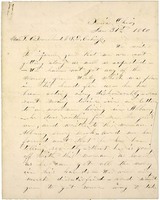 Letter from Jane and Elvira Townsend to S. D. Cabaniss, 1860
Letter from Jane and Elvira Townsend to S. D. Cabaniss, 1860 [page 1]
Xenia, Ohio
Jan. 31st 1860
Messrs. S. C. Townshend & S. D. Cabiness,
We write to inform you that we are not getting along as well as expected -- We have not got any money from Wesley which was placed in his hands for us -- he has been acting very dishonorably -- has sent money twice in a letter to a woman living in Albany -- he does nothing for me, has quit me and write to this women in Albany ever week -- and we have found out that he has been telling secretly -- that he is going off with this woman, as soon as he can get all the money in his hands -- We are very much dissatisfied -- and want you to get some way to take
[page 2]
us back home -- we do not want you to send us any more money -- unless you place it in the hands of some one, in whom we can place more confidence than we can in Wesley -- Please write soon and let us know what we are to do.
Yours &c.
Jane
P. S. Wesley has not been doing any thing for us -- he treats Jane very badly -- but has given money to his sister and buy's a great many things for her -- I would like very much to go back, and stay until my mother comes -- They all appear pretty well satisfied -- but Jane and myself -- some of the children -- and Willis -- and me want to go back -- My brother somehow or other had all his clothes misplaced on the car's
[page 3]
and lost them —- he has got one pair of pants and one shirt since we came here—- Willis and my brother are at the Yellow Springs going to school and are getting along very well -- Jane and I are both very anxious to go back -- write soon & let us know what we are to do -- direct the letter to us here at Xenia.
Green County
Ohio
Yours &c.
Alvira
-
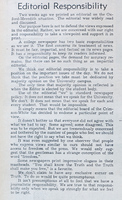 Editorial Responsibility
Editorial Responsibility Written around the time of the integration of the University of Mississippi by James Meredith and the riots that followed.
A followup to "A Bell Rang," written after Meredith was able to enroll, it discusses negative reaction to the previous piece and the responsibility of editors in publishing editorials. It also argues that the editorial "we" should not be understood to reflect the views of the whole campus.
-
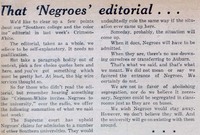 That 'Negroes' Editorial...
That 'Negroes' Editorial... Written after and in response to the enrollment of a Black student to the University of Tennessee's Law School.
A followup piece to "The Southern College and the Color Line," it reiterates the newspaper's stance: it does not want Black students to be admitted but recognizes that this will be inevitable and is nothing to panic about.
-
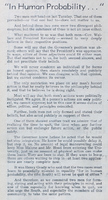 "In Human Probability..."
"In Human Probability..." Written two days after the "Stand in the Schoolhouse Door," Gov. George Wallace's unsuccessful attempt to prevent two Black students, Vivian Malone and James Hood, from enrolling at the University of Alabama. It contrasts Wallace with U.S. President John F. Kennedy, driving the opposition against these actions, and praises each for doing what he felt was right. It also shows appreciation for Wallace "for knowing when to quit."
Note: The title, as indicated in the article, comes from a quote from an 1888 speech by Southern journalist and speaker Henry Grady, regarding his contention that Black and white Southerners must learn to coexist, peacefully but separately, because the South will "never be quit of either."
-
 A Harvest of Hostility
A Harvest of Hostility Written in the aftermath of a period of nationally prominent civil rights protesting and race-related rioting in Birmingham.
It observes that one of the problems of race relations is "the tendency to think in terms of ultimates or extremes." It then directs questions to both the "ardent segregationist" and the integrationist "agitator." While it argues that change is inevitable, it rejects the speed of change and warns that agitation brings negative consequences.
-
 An Apparent Contrast
An Apparent Contrast Written after the inauguration of Alabama's new attorney general, Richmond Flowers, and its new governor, George Wallace.
It contrasts the men's attitudes regarding the potential integration of Alabama schools. It references the integration-related rioting at the University of Mississippi of the previous year and quotes from Wallace's inauguration speech, in which he promised "segregation now, segregation tomorrow, segregation forever."
-
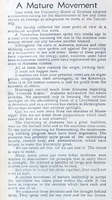 A Mature Movement
A Mature Movement Written after the riots at the University of Mississippi at its integration.
It urges Alabama to "profit from the mistakes of others" and prepare to meet future integration attempts without violence, which will require strong, mature leadership.
-
 54°40' or Fight
54°40' or Fight Written after the resolution of the riots that took place at the University of Mississippi over the enrollment of Black student James Meredith.
It criticizes Alabama's governor-elect, George Wallace, for his confrontational approach to resisting integration, particularly his calling on the state police for support, which would pit them against other law enforcement brought in by the federal government.
Note: The title is a reference to the 19th century dispute between the U.S. and Britain over Oregon Country. The slogan "Fifty-four Forty or Fight!" was a call for the U.S. to claim not just that territory but to annex everything up to parallel 54°40′ -- that is, territory which is now Canada, up to the southern border of Alaska. In 1846, the boundary was settled at the more moderate parallel 49°.
-
 A Bell Rang...
A Bell Rang... Written around the time of the integration of the University of Mississippi by James Meredith and the riots that followed.
It reflects on the initial success of the Mississippi governor in keeping Meredith out, viewing it as a dangerous precedent. It cautions that bowing to "the bigot or the demagogue" would not stop at preventing Black people from being in a place they are not wanted but would be turned on other minority groups to do the same.
Note: The title, as indicated in the piece, refers to a line from a 1623 meditation by the poet John Donne, which argues that everyone is part of mankind and thus has a responsibility toward others.
-
 Please, Mr. Wallace
Please, Mr. Wallace Written after the victory of George Wallace in the Democratic party primary for governor of Alabama; with no Republican opposing him, he was virtually guaranteed to win the general election.
It addresses Wallace's campaign promises, particularly his pledge to "stand in the schoolhouse door" to prevent integration of schools. It imagines what would happen if he took this "stand" and implores him to bring about his aims without violence, for the sake of the state's reputation.
-
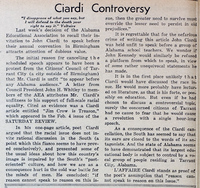 Ciardi Controversy
Ciardi Controversy Written after the Alabama Association of Education rescinded the speaking invitation of poet John Ciardi, based on a magazine article he wrote about the Jim Crow South.
It argues that the cancellation of this speaking engagement was unnecessary (Ciardi would likely have spoken about literary topics) and moreover only proved Ciardi's point from the article: that people in the South cannot have a rational discussion about race.
-
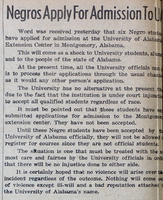 Negroes Apply for Admission to UA
Negroes Apply for Admission to UA Written after and in response to news of the application of six Black students to the University of Alabama's Montgomery extension center.
It attempts to clarify the situation -- that there is no reason to think the main campus will be desegregated -- and says it hopes to see no violence in response.
-
 Cross Burning on Campus
Cross Burning on Campus Written after a cross was burned on campus.
It conjectures that the deed may have been a prank, but as a symbol it will "only add fuel to the already-burning fire in the South." It also references Autherine Lucy's enrollment in 1954 and cautions against the kind of violence that came in reaction.
-
 Right, Wrong; Who's to Say?
Right, Wrong; Who's to Say? Written in response to related two local incidents: the Ku Klux Klan erecting a sign on a major highway and a student later covering it with paint.
The author, the newspaper's editor, Bob Cohn, identifies himself and explains that he is Jewish. It is his reflection on how to cover these stories for the newspaper.
-
 Tradition Holds Strong
Tradition Holds Strong Written after an in response to the suspension of racial integration at Central High School in Little Rock, Arkansas.
It argues that forced segregation has in general caused tension, and that allowing the South to move in this direction at its own pace is best.
-
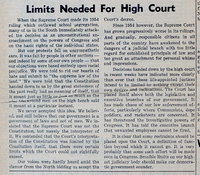 Limits Needed for High Court
Limits Needed for High Court Written in response to several cases "handed down by the high court in recent weeks." (See note below.)
It argues that the U.S. Supreme Court needs to be brought back into balance with the other branches of government. It specifically mentions the 1954 Brown v. Board of Education decision, calling it "an encroachment on the powers of Congress and on the basic rights of the individual states."
Note: It is difficult to know which specific case(s) this was written in reaction to. On June 17, several decisions were announced that put communists and socialists on the winning side, particularly Yates v. United States, which clarified First Amendment protections for radical speech, and Sweezy v. New Hampshire, which involved academic freedom of speech. It may also be a general response to the liberal nature of the Court under Chief Justice Earl Warren.
-
 Comparison by Contrast
Comparison by Contrast Written after an altercation between students at a debate forum and a local Ku Klux Klan group.
It contrasts the motives and behavior of the two groups.
-
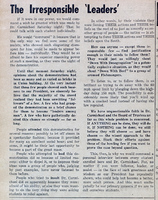 The Irresponsible 'Leaders'
The Irresponsible 'Leaders' Written days after Autherine Lucy's attempt to integrate the University and the riots that followed.
It shows sympathy with most people attending the violent protests, laying the blame on the "zealots" in the crowd and its leadership. It also calls for students to listen to President Carmichael.
-
 Proving Grounds
Proving Grounds Written soon after the Supreme Court decision in Brown v. Board of Education II.
It reflects on the role of higher education in dismantling segregation.
-
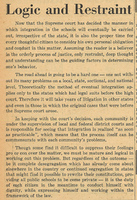 Logic and Restraint
Logic and Restraint Written in response to the recent Supreme Court decision in Brown vs. Board of Education II, which clarified that district courts would be tasked with carrying out integration and that it should happen "with all deliberate speed."
It argues that the task will be difficult, but, no matter the outcome, everyone should behave within the law.
-
 Desegregation -- May There Be No Sudden Flux
Desegregation -- May There Be No Sudden Flux Written a few months after the Brown v. Board of Education decision that found racial segregation in schools to be unconstitutional.
It reflects on the likely changes coming in the future and calls for gradual integration. It argues that while for many whites "Negroes as a group have an unfavorable connotation," specific Black people typically do not. Therefore, letting individual Black students prove themselves is a better option than a "sudden flux."
-
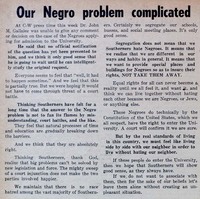 Our Negro Problem Complicated
Our Negro Problem Complicated Written as commentary on the possible entrance of Black students to the University of Alabama and the attitude of white Southerners to Black people.
It argues that white Southerners do not want to be forced into such changes, but that contrary to hating Black people, they want to "provide special places and buildings for Negroes" as a means of protecting their rights. In the event that Black students are admitted, it calls for rational, measured behavior.
-
 The Southern College and the Color Line
The Southern College and the Color Line Written after and in response to the enrollment of a Black student to the University of Tennessee's Law School.
It argues that the University of Alabama will soon probably face something similar, adding, "And like it or not, we might as well get ready." It also indicates that while there may be initial backlash, the fact that white Southerners share spaces with Black Southerners on a regular basis indicates they will eventually accept this.
 Letter from Jane and Elvira Townsend to S. D. Cabaniss, 1860 [page 1] Xenia, Ohio Jan. 31st 1860 Messrs. S. C. Townshend & S. D. Cabiness, We write to inform you that we are not getting along as well as expected -- We have not got any money from Wesley which was placed in his hands for us -- he has been acting very dishonorably -- has sent money twice in a letter to a woman living in Albany -- he does nothing for me, has quit me and write to this women in Albany ever week -- and we have found out that he has been telling secretly -- that he is going off with this woman, as soon as he can get all the money in his hands -- We are very much dissatisfied -- and want you to get some way to take [page 2] us back home -- we do not want you to send us any more money -- unless you place it in the hands of some one, in whom we can place more confidence than we can in Wesley -- Please write soon and let us know what we are to do. Yours &c. Jane P. S. Wesley has not been doing any thing for us -- he treats Jane very badly -- but has given money to his sister and buy's a great many things for her -- I would like very much to go back, and stay until my mother comes -- They all appear pretty well satisfied -- but Jane and myself -- some of the children -- and Willis -- and me want to go back -- My brother somehow or other had all his clothes misplaced on the car's [page 3] and lost them —- he has got one pair of pants and one shirt since we came here—- Willis and my brother are at the Yellow Springs going to school and are getting along very well -- Jane and I are both very anxious to go back -- write soon & let us know what we are to do -- direct the letter to us here at Xenia. Green County Ohio Yours &c. Alvira
Letter from Jane and Elvira Townsend to S. D. Cabaniss, 1860 [page 1] Xenia, Ohio Jan. 31st 1860 Messrs. S. C. Townshend & S. D. Cabiness, We write to inform you that we are not getting along as well as expected -- We have not got any money from Wesley which was placed in his hands for us -- he has been acting very dishonorably -- has sent money twice in a letter to a woman living in Albany -- he does nothing for me, has quit me and write to this women in Albany ever week -- and we have found out that he has been telling secretly -- that he is going off with this woman, as soon as he can get all the money in his hands -- We are very much dissatisfied -- and want you to get some way to take [page 2] us back home -- we do not want you to send us any more money -- unless you place it in the hands of some one, in whom we can place more confidence than we can in Wesley -- Please write soon and let us know what we are to do. Yours &c. Jane P. S. Wesley has not been doing any thing for us -- he treats Jane very badly -- but has given money to his sister and buy's a great many things for her -- I would like very much to go back, and stay until my mother comes -- They all appear pretty well satisfied -- but Jane and myself -- some of the children -- and Willis -- and me want to go back -- My brother somehow or other had all his clothes misplaced on the car's [page 3] and lost them —- he has got one pair of pants and one shirt since we came here—- Willis and my brother are at the Yellow Springs going to school and are getting along very well -- Jane and I are both very anxious to go back -- write soon & let us know what we are to do -- direct the letter to us here at Xenia. Green County Ohio Yours &c. Alvira Editorial Responsibility Written around the time of the integration of the University of Mississippi by James Meredith and the riots that followed. A followup to "A Bell Rang," written after Meredith was able to enroll, it discusses negative reaction to the previous piece and the responsibility of editors in publishing editorials. It also argues that the editorial "we" should not be understood to reflect the views of the whole campus.
Editorial Responsibility Written around the time of the integration of the University of Mississippi by James Meredith and the riots that followed. A followup to "A Bell Rang," written after Meredith was able to enroll, it discusses negative reaction to the previous piece and the responsibility of editors in publishing editorials. It also argues that the editorial "we" should not be understood to reflect the views of the whole campus. That 'Negroes' Editorial... Written after and in response to the enrollment of a Black student to the University of Tennessee's Law School. A followup piece to "The Southern College and the Color Line," it reiterates the newspaper's stance: it does not want Black students to be admitted but recognizes that this will be inevitable and is nothing to panic about.
That 'Negroes' Editorial... Written after and in response to the enrollment of a Black student to the University of Tennessee's Law School. A followup piece to "The Southern College and the Color Line," it reiterates the newspaper's stance: it does not want Black students to be admitted but recognizes that this will be inevitable and is nothing to panic about. "In Human Probability..." Written two days after the "Stand in the Schoolhouse Door," Gov. George Wallace's unsuccessful attempt to prevent two Black students, Vivian Malone and James Hood, from enrolling at the University of Alabama. It contrasts Wallace with U.S. President John F. Kennedy, driving the opposition against these actions, and praises each for doing what he felt was right. It also shows appreciation for Wallace "for knowing when to quit." Note: The title, as indicated in the article, comes from a quote from an 1888 speech by Southern journalist and speaker Henry Grady, regarding his contention that Black and white Southerners must learn to coexist, peacefully but separately, because the South will "never be quit of either."
"In Human Probability..." Written two days after the "Stand in the Schoolhouse Door," Gov. George Wallace's unsuccessful attempt to prevent two Black students, Vivian Malone and James Hood, from enrolling at the University of Alabama. It contrasts Wallace with U.S. President John F. Kennedy, driving the opposition against these actions, and praises each for doing what he felt was right. It also shows appreciation for Wallace "for knowing when to quit." Note: The title, as indicated in the article, comes from a quote from an 1888 speech by Southern journalist and speaker Henry Grady, regarding his contention that Black and white Southerners must learn to coexist, peacefully but separately, because the South will "never be quit of either." A Harvest of Hostility Written in the aftermath of a period of nationally prominent civil rights protesting and race-related rioting in Birmingham. It observes that one of the problems of race relations is "the tendency to think in terms of ultimates or extremes." It then directs questions to both the "ardent segregationist" and the integrationist "agitator." While it argues that change is inevitable, it rejects the speed of change and warns that agitation brings negative consequences.
A Harvest of Hostility Written in the aftermath of a period of nationally prominent civil rights protesting and race-related rioting in Birmingham. It observes that one of the problems of race relations is "the tendency to think in terms of ultimates or extremes." It then directs questions to both the "ardent segregationist" and the integrationist "agitator." While it argues that change is inevitable, it rejects the speed of change and warns that agitation brings negative consequences. An Apparent Contrast Written after the inauguration of Alabama's new attorney general, Richmond Flowers, and its new governor, George Wallace. It contrasts the men's attitudes regarding the potential integration of Alabama schools. It references the integration-related rioting at the University of Mississippi of the previous year and quotes from Wallace's inauguration speech, in which he promised "segregation now, segregation tomorrow, segregation forever."
An Apparent Contrast Written after the inauguration of Alabama's new attorney general, Richmond Flowers, and its new governor, George Wallace. It contrasts the men's attitudes regarding the potential integration of Alabama schools. It references the integration-related rioting at the University of Mississippi of the previous year and quotes from Wallace's inauguration speech, in which he promised "segregation now, segregation tomorrow, segregation forever." A Mature Movement Written after the riots at the University of Mississippi at its integration. It urges Alabama to "profit from the mistakes of others" and prepare to meet future integration attempts without violence, which will require strong, mature leadership.
A Mature Movement Written after the riots at the University of Mississippi at its integration. It urges Alabama to "profit from the mistakes of others" and prepare to meet future integration attempts without violence, which will require strong, mature leadership. 54°40' or Fight Written after the resolution of the riots that took place at the University of Mississippi over the enrollment of Black student James Meredith. It criticizes Alabama's governor-elect, George Wallace, for his confrontational approach to resisting integration, particularly his calling on the state police for support, which would pit them against other law enforcement brought in by the federal government. Note: The title is a reference to the 19th century dispute between the U.S. and Britain over Oregon Country. The slogan "Fifty-four Forty or Fight!" was a call for the U.S. to claim not just that territory but to annex everything up to parallel 54°40′ -- that is, territory which is now Canada, up to the southern border of Alaska. In 1846, the boundary was settled at the more moderate parallel 49°.
54°40' or Fight Written after the resolution of the riots that took place at the University of Mississippi over the enrollment of Black student James Meredith. It criticizes Alabama's governor-elect, George Wallace, for his confrontational approach to resisting integration, particularly his calling on the state police for support, which would pit them against other law enforcement brought in by the federal government. Note: The title is a reference to the 19th century dispute between the U.S. and Britain over Oregon Country. The slogan "Fifty-four Forty or Fight!" was a call for the U.S. to claim not just that territory but to annex everything up to parallel 54°40′ -- that is, territory which is now Canada, up to the southern border of Alaska. In 1846, the boundary was settled at the more moderate parallel 49°. A Bell Rang... Written around the time of the integration of the University of Mississippi by James Meredith and the riots that followed. It reflects on the initial success of the Mississippi governor in keeping Meredith out, viewing it as a dangerous precedent. It cautions that bowing to "the bigot or the demagogue" would not stop at preventing Black people from being in a place they are not wanted but would be turned on other minority groups to do the same. Note: The title, as indicated in the piece, refers to a line from a 1623 meditation by the poet John Donne, which argues that everyone is part of mankind and thus has a responsibility toward others.
A Bell Rang... Written around the time of the integration of the University of Mississippi by James Meredith and the riots that followed. It reflects on the initial success of the Mississippi governor in keeping Meredith out, viewing it as a dangerous precedent. It cautions that bowing to "the bigot or the demagogue" would not stop at preventing Black people from being in a place they are not wanted but would be turned on other minority groups to do the same. Note: The title, as indicated in the piece, refers to a line from a 1623 meditation by the poet John Donne, which argues that everyone is part of mankind and thus has a responsibility toward others. Please, Mr. Wallace Written after the victory of George Wallace in the Democratic party primary for governor of Alabama; with no Republican opposing him, he was virtually guaranteed to win the general election. It addresses Wallace's campaign promises, particularly his pledge to "stand in the schoolhouse door" to prevent integration of schools. It imagines what would happen if he took this "stand" and implores him to bring about his aims without violence, for the sake of the state's reputation.
Please, Mr. Wallace Written after the victory of George Wallace in the Democratic party primary for governor of Alabama; with no Republican opposing him, he was virtually guaranteed to win the general election. It addresses Wallace's campaign promises, particularly his pledge to "stand in the schoolhouse door" to prevent integration of schools. It imagines what would happen if he took this "stand" and implores him to bring about his aims without violence, for the sake of the state's reputation. Ciardi Controversy Written after the Alabama Association of Education rescinded the speaking invitation of poet John Ciardi, based on a magazine article he wrote about the Jim Crow South. It argues that the cancellation of this speaking engagement was unnecessary (Ciardi would likely have spoken about literary topics) and moreover only proved Ciardi's point from the article: that people in the South cannot have a rational discussion about race.
Ciardi Controversy Written after the Alabama Association of Education rescinded the speaking invitation of poet John Ciardi, based on a magazine article he wrote about the Jim Crow South. It argues that the cancellation of this speaking engagement was unnecessary (Ciardi would likely have spoken about literary topics) and moreover only proved Ciardi's point from the article: that people in the South cannot have a rational discussion about race. Negroes Apply for Admission to UA Written after and in response to news of the application of six Black students to the University of Alabama's Montgomery extension center. It attempts to clarify the situation -- that there is no reason to think the main campus will be desegregated -- and says it hopes to see no violence in response.
Negroes Apply for Admission to UA Written after and in response to news of the application of six Black students to the University of Alabama's Montgomery extension center. It attempts to clarify the situation -- that there is no reason to think the main campus will be desegregated -- and says it hopes to see no violence in response. Cross Burning on Campus Written after a cross was burned on campus. It conjectures that the deed may have been a prank, but as a symbol it will "only add fuel to the already-burning fire in the South." It also references Autherine Lucy's enrollment in 1954 and cautions against the kind of violence that came in reaction.
Cross Burning on Campus Written after a cross was burned on campus. It conjectures that the deed may have been a prank, but as a symbol it will "only add fuel to the already-burning fire in the South." It also references Autherine Lucy's enrollment in 1954 and cautions against the kind of violence that came in reaction. Right, Wrong; Who's to Say? Written in response to related two local incidents: the Ku Klux Klan erecting a sign on a major highway and a student later covering it with paint. The author, the newspaper's editor, Bob Cohn, identifies himself and explains that he is Jewish. It is his reflection on how to cover these stories for the newspaper.
Right, Wrong; Who's to Say? Written in response to related two local incidents: the Ku Klux Klan erecting a sign on a major highway and a student later covering it with paint. The author, the newspaper's editor, Bob Cohn, identifies himself and explains that he is Jewish. It is his reflection on how to cover these stories for the newspaper. Tradition Holds Strong Written after an in response to the suspension of racial integration at Central High School in Little Rock, Arkansas. It argues that forced segregation has in general caused tension, and that allowing the South to move in this direction at its own pace is best.
Tradition Holds Strong Written after an in response to the suspension of racial integration at Central High School in Little Rock, Arkansas. It argues that forced segregation has in general caused tension, and that allowing the South to move in this direction at its own pace is best. Limits Needed for High Court Written in response to several cases "handed down by the high court in recent weeks." (See note below.) It argues that the U.S. Supreme Court needs to be brought back into balance with the other branches of government. It specifically mentions the 1954 Brown v. Board of Education decision, calling it "an encroachment on the powers of Congress and on the basic rights of the individual states." Note: It is difficult to know which specific case(s) this was written in reaction to. On June 17, several decisions were announced that put communists and socialists on the winning side, particularly Yates v. United States, which clarified First Amendment protections for radical speech, and Sweezy v. New Hampshire, which involved academic freedom of speech. It may also be a general response to the liberal nature of the Court under Chief Justice Earl Warren.
Limits Needed for High Court Written in response to several cases "handed down by the high court in recent weeks." (See note below.) It argues that the U.S. Supreme Court needs to be brought back into balance with the other branches of government. It specifically mentions the 1954 Brown v. Board of Education decision, calling it "an encroachment on the powers of Congress and on the basic rights of the individual states." Note: It is difficult to know which specific case(s) this was written in reaction to. On June 17, several decisions were announced that put communists and socialists on the winning side, particularly Yates v. United States, which clarified First Amendment protections for radical speech, and Sweezy v. New Hampshire, which involved academic freedom of speech. It may also be a general response to the liberal nature of the Court under Chief Justice Earl Warren. Comparison by Contrast Written after an altercation between students at a debate forum and a local Ku Klux Klan group. It contrasts the motives and behavior of the two groups.
Comparison by Contrast Written after an altercation between students at a debate forum and a local Ku Klux Klan group. It contrasts the motives and behavior of the two groups. The Irresponsible 'Leaders' Written days after Autherine Lucy's attempt to integrate the University and the riots that followed. It shows sympathy with most people attending the violent protests, laying the blame on the "zealots" in the crowd and its leadership. It also calls for students to listen to President Carmichael.
The Irresponsible 'Leaders' Written days after Autherine Lucy's attempt to integrate the University and the riots that followed. It shows sympathy with most people attending the violent protests, laying the blame on the "zealots" in the crowd and its leadership. It also calls for students to listen to President Carmichael. Proving Grounds Written soon after the Supreme Court decision in Brown v. Board of Education II. It reflects on the role of higher education in dismantling segregation.
Proving Grounds Written soon after the Supreme Court decision in Brown v. Board of Education II. It reflects on the role of higher education in dismantling segregation. Logic and Restraint Written in response to the recent Supreme Court decision in Brown vs. Board of Education II, which clarified that district courts would be tasked with carrying out integration and that it should happen "with all deliberate speed." It argues that the task will be difficult, but, no matter the outcome, everyone should behave within the law.
Logic and Restraint Written in response to the recent Supreme Court decision in Brown vs. Board of Education II, which clarified that district courts would be tasked with carrying out integration and that it should happen "with all deliberate speed." It argues that the task will be difficult, but, no matter the outcome, everyone should behave within the law. Desegregation -- May There Be No Sudden Flux Written a few months after the Brown v. Board of Education decision that found racial segregation in schools to be unconstitutional. It reflects on the likely changes coming in the future and calls for gradual integration. It argues that while for many whites "Negroes as a group have an unfavorable connotation," specific Black people typically do not. Therefore, letting individual Black students prove themselves is a better option than a "sudden flux."
Desegregation -- May There Be No Sudden Flux Written a few months after the Brown v. Board of Education decision that found racial segregation in schools to be unconstitutional. It reflects on the likely changes coming in the future and calls for gradual integration. It argues that while for many whites "Negroes as a group have an unfavorable connotation," specific Black people typically do not. Therefore, letting individual Black students prove themselves is a better option than a "sudden flux." Our Negro Problem Complicated Written as commentary on the possible entrance of Black students to the University of Alabama and the attitude of white Southerners to Black people. It argues that white Southerners do not want to be forced into such changes, but that contrary to hating Black people, they want to "provide special places and buildings for Negroes" as a means of protecting their rights. In the event that Black students are admitted, it calls for rational, measured behavior.
Our Negro Problem Complicated Written as commentary on the possible entrance of Black students to the University of Alabama and the attitude of white Southerners to Black people. It argues that white Southerners do not want to be forced into such changes, but that contrary to hating Black people, they want to "provide special places and buildings for Negroes" as a means of protecting their rights. In the event that Black students are admitted, it calls for rational, measured behavior. The Southern College and the Color Line Written after and in response to the enrollment of a Black student to the University of Tennessee's Law School. It argues that the University of Alabama will soon probably face something similar, adding, "And like it or not, we might as well get ready." It also indicates that while there may be initial backlash, the fact that white Southerners share spaces with Black Southerners on a regular basis indicates they will eventually accept this.
The Southern College and the Color Line Written after and in response to the enrollment of a Black student to the University of Tennessee's Law School. It argues that the University of Alabama will soon probably face something similar, adding, "And like it or not, we might as well get ready." It also indicates that while there may be initial backlash, the fact that white Southerners share spaces with Black Southerners on a regular basis indicates they will eventually accept this.